|
|
|
 |
| |
MI6 caught up with Ben Macintyre, author of the
new book "For Your Eyes Only: Ian Fleming + James
Bond" in collaboration with the Imperial War Museum...
|
|
Ben Macintyre Interview
9th June 2008
|
How did you become a writer/journalist?
I was doing a post graduate degree in America, and to make ends met I started
freelancing for British newspapers. That is where it started, my first jobs
were all abroad really, I was a New York correspondent and then Paris correspondent
and Washington correspondent for The Times. While I was abroad I started
writing books as well. I had written one before I went to New York and than
did one every few years while I was out there. The Ian Fleming book is a
departure for me really because, most of the books I’ve done, I’ve
done six in all been narrative driven history books. They are taking real
people and real events and telling there stories in a narrative way. So the
James Bond book is a one off for me.
How did you come to work on the "For Your Eyes Only:
Ian Fleming + James Bond" book for the Imperial
War Museum exhibition?
Basically it was a partnership with the Imperial War Museum, they helped me
by providing lots of the research and lots of expertise and we exchanged notes
as we went along. A lot of their ideas appear in the text and I expect a fair
bit of stuff appears in the exhibition.
|
|
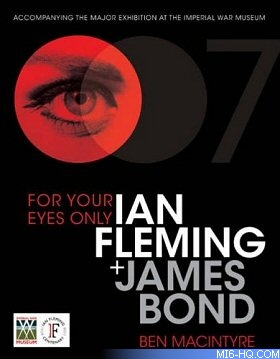
 Order
Amazon UK (Hardback) Order
Amazon UK (Hardback)
 Order
Amazon USA (Hardback) Order
Amazon USA (Hardback)
|
It was a partnership .I was approached about
a year and a half ago now, I really think it was the Fleming
family, who had read
some of the things I had written about James Bond over the years
and also they had read Agent ZigZag. I think as they through
Agent ZigZag had done very well they thought that I would be
a good name to attach to it. I was delighted, as it was a kind
of side job for me, it was not one of my usually types of books,
it was lovely to have a change of pace.
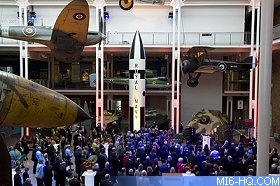
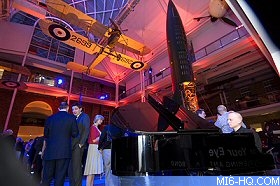 Above:
Shots from the launch event of the Ian Fleming exhibition
at the IWM. Above:
Shots from the launch event of the Ian Fleming exhibition
at the IWM. |
|
How closely did you work with the museum to
ensure what you wrote was relevant?
You’ve put your finger on one of the interesting things, the thing about
working with a museum. What I was writing had to go to press considerably early
than the museum who’s exhibition was not ready. So in a way it is a standalone
book, it was invented before the exhibition had come into focus. Even though
it accompanies the exhibition its by no means a catalogue of the exhibition.
In a way I set myself my own brief for the book which was to try and work out
where Ian Fleming ends and where James Bond begins. So it's the intersection
between two lives: one real and one fictional. In a way that was the brief
I came up with for myself. Obviously that is not the way the exhibition describes
itself . In the end though both mesh together surprisingly well I think.
What did you think of the exhibition?
I loved the exhibition, and I think I would have to say that even if I didn’t
think it, but I do think it. I think they’ve done a brilliant job, I think
its got a wonderful range of material in it. It's intended to appeal to all ages
and both sexes. |
It's very cleverly done, and it’s a difficult thing to
do in away... They’ve had to marry up to different things
- the world on Ian Fleming inhabited, and what has become a very
filmic world, while keeping
the books front and centre. The things that I like best there, and this may be
a historian talking here, are the war time notebooks that show
how deeply
Fleming
was involved in navel intelligence, and how much he was aware
of all those extraordinary plans and secrets that were going
on
at the
time. That’s the bit I loved best, but of course its very
hard to resist the gadgets too, Little Nellie is a fantastic
looking thing as well.
Were you aware of the greater world of
James Bond before writing the book?
Do you know what, I wasn’t really. I didn’t realise there was this
enormous world out there of the James Bond enthusiast, and its been great,
to discover that there are all these extraordinary outlets, and they’ve
been brilliant, and they all know more about James Bond than I do. I’ve
been impressed with them all, it’s been brilliant so far.
Which was the first Fleming
book you read, and which is
your favourite?
Funnily enough they are the same book, I first read Casino
Royale, it’s
the first Bond book and I still think it’s the best. It’s got a
fantastic raw kind of power and characterisation. Fleming just managed to invent
this figure out of nowhere. And for me Casino Royale pound for pound is still
the best of them.
|
|
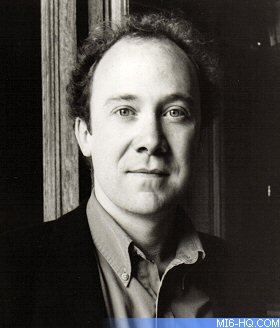
Above: Author Ben Macintyre |
Which cover art from the Bound
Bond expo
did you find most interesting?
That’s a very good question... I think the Richard Chopping covers are
very hard to beat - they have a classic clarity to them. They are iconic feel
that works brilliantly well, I think it was one of Fleming's acts of genius was
to get Chopping to do the covers. They have this incredible versatility, they
look terribly simple, but they are visually very clever, they have great subtlety
to them. But then again I really adore the Pan covers, the really early ones,
I think they are brilliant. I think I’m going to have to say I’m
agnostic on them, I think they are all brilliant.
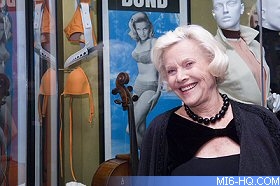
Above: Bond girl Honor Blackman at
the opening of the exhibition last month |
|
Can you talk us through the process off writing
the book? Of the chapters in the book with was the most complex
to write?
It was a very fast the deadline and we had to get done very quickly. A lot
of the research was brilliantly done by the Imperial War Museum, and they provided
a lot of the leg work which was really helpful. The process really went as
we
wrote it chapter by chapter. I would write my take on it and I would send it
to Terry Charman who is the historian at the Imperial War Museum and he would
annotate it and add his thoughts to it and then it would come back to me.
|
Because we were running so fast I had to get
the chapters to the publisher as I wrote them and we did the
illustrations as
we went along. Unlike most books which you write you get all
the pictures and present it as a finished object. This was very
much done on the run as it where. The most complicated chapter
I found, because there were so many different bits to it, was
trying to identify the real life individuals on which the main
characters were based. So the real human beings who were James
Bond and the real Moneypenny’s, and M, which was both fascinating
but quite tricky to piece together, so definitely that chapter.
In your opinion, what or who was the biggest
influence on Fleming, and his creation?
That depends on whether it's the biggest influence in terms
of which character he based James Bond on, or which individual
influenced him to write. If it’s the
latter I would have to say Peter Fleming, his brother. I think having a brother
who was such a successful novelist so early in life, Peter was his kind of
model in a way as a writer, so I think a lot of credit
goes to him. I think Ann in
her own waspish way pushed him to write, I think it was a great effect, also
Noel Coward was a great encourager of his writing so he clearly helped as well.
In terms of which character James Bond is
based on, I would have to say it was Lieutenant Commander
Patrick
Dalzel-Job, he was the commander in 30 AU. He was an extraordinary
dare devil figure capable of skiing backwards, setting off bombs underwater.
He probably had the strongest claim.
What was the most insightful or interesting thing you learned about Fleming?
Generally speaking, I would have to say Fleming’s extraordinary reliance
on reality to inform his fiction. All novelists do this - write from what they
know and use of things they have seen and places they’ve been to inform
there writing.
Fleming was so craftsmanly in taking real life and turning
it into fiction, the fact that every gizmo and every gadget, plot, person,
place
and clothing, its all comes from reality, and that makes it for a historical
a particularly rich source. |
|
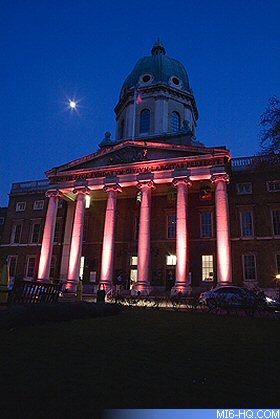
Event Info
Imperial War Museum London, Lambeth Road, London
SE1 6HZ. 10.00am - 6.00pm. Adults £8.00,
Concessions and Groups £7.00, Children £4.00, Family £19.00
(Groups prebooking essential on 020 7416 5439 or [email protected]). Enquiries
020 7416 5320/5321. www.iwm.org.uk. Click
here to visit the official event website. |
|
Can you tell us a little
about the cross over from page to screen? How did Fleming react?
I think Fleming took a very
sensible position on this, although he all ways wanted his books
to be filmed and expected them to
be filmed. Once the filming process began he very much stood
back from it and let it take its own course. He did go on set
for the first film - he was really a visitor he was not there
as an advisor. He was not there to tell them how to do it. I
think he very swiftly and sensibly realised that the two media
are
so different, that the only way to do it was to hand over the
book and say 'right off you go and do your thing now'. I think
that worked very well, I think he was very pleased with the results,
and so he should have been. He was always complimentary
about them in a slightly distant way. I don’t think he
felt they were his, so he didn’t have to take a strong
responsibility for them. It took a surprisingly long time for
the films to be made, in fact it was not until 1962 that Dr
No got
off the ground, that’s
quite a long time, being the last ten years of his life.
The official
book to accompany the Imperial War Museum exhibition For Your
Eyes Only: Ian Fleming and James Bond was published
by Bloomsbury in April 2008. Written by the bestselling author
of Costa shortlisted Agent Zigzag, Ben Macintyre, and full
of lavish photography, this book is the perfect celebration
of Ian Fleming and his remarkable creation, James Bond. The
For You Eyes Only: Ian Fleming and James Bond exhibition is part of the Ian Fleming Centenary celebrations.
Related Articles
 For
Your Eyes Only: Ian Fleming + James Bond - Book Preview For
Your Eyes Only: Ian Fleming + James Bond - Book Preview
 For
Your Eyes Only - Exhibition Opens For
Your Eyes Only - Exhibition Opens
 Bond
Bound - Exhibition Opens Bond
Bound - Exhibition Opens
Thanks to Ben Macintyre and Bloomsbury.
|
|
|